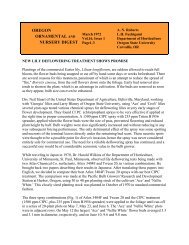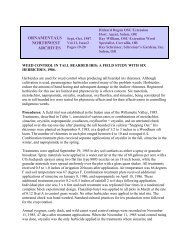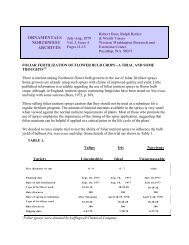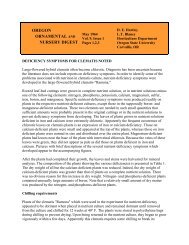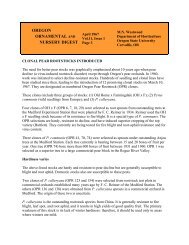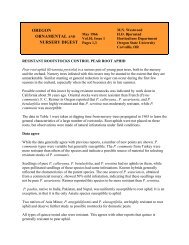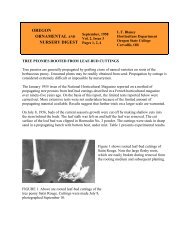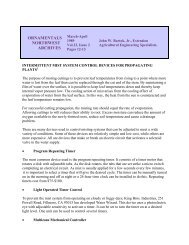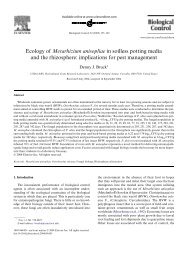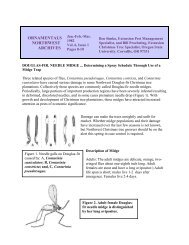Spraying Leaves of Pear Nursery Trees with Urea and Copper ...
Spraying Leaves of Pear Nursery Trees with Urea and Copper ...
Spraying Leaves of Pear Nursery Trees with Urea and Copper ...
Create successful ePaper yourself
Turn your PDF publications into a flip-book with our unique Google optimized e-Paper software.
RESEARCH REPORTS<br />
from trees sprayed <strong>with</strong> urea had similar<br />
N concentrations <strong>and</strong> developed<br />
similar lesions as trees sprayed <strong>with</strong> a<br />
combination <strong>of</strong> urea <strong>and</strong> CuEDTA,<br />
regardless <strong>of</strong> when trees were sprayed.<br />
Lesion size was not correlated<br />
<strong>with</strong> stem N concentrations when trees<br />
were sprayed <strong>with</strong> water or CuEDTA<br />
in October (R < 0.350; P > 0.05).<br />
Lesions size was positively correlated<br />
(P < 0.05) <strong>with</strong> stem N concentrations<br />
when trees were sprayed <strong>with</strong> urea (R =<br />
0.700; P < 0.05) or a combination<br />
<strong>of</strong> urea <strong>and</strong> CuEDTA (R = 0.573; P <<br />
0.05) in October. Lesion size was<br />
positively correlated <strong>with</strong> stem N concentrations<br />
when trees were sprayed<br />
<strong>with</strong> water (R = 0.632; P < 0.05) or<br />
CuEDTA (R = 0.574; P < 0.05) in<br />
November, <strong>and</strong> lesion size was not<br />
correlated <strong>with</strong> stem N concentrations<br />
when trees were sprayed <strong>with</strong> urea or<br />
a combination <strong>of</strong> urea <strong>and</strong> CuEDTA in<br />
November (R < 0.221; P > 0.05).<br />
EXPERIMENT 3. Lesions developed<br />
on over 75% <strong>of</strong> wounds (data<br />
not shown). <strong>Trees</strong> sprayed <strong>with</strong> the<br />
urea treatment (urea <strong>and</strong> CuEDTA)<br />
in October defoliated before trees<br />
that were sprayed <strong>with</strong> the urea treatment<br />
in November (data not shown).<br />
Between October <strong>and</strong> November,<br />
stem N concentrations increased<br />
in trees from all spray treatments <strong>and</strong><br />
lesion size increased between October<br />
<strong>and</strong> November when trees were<br />
sprayed <strong>with</strong> water or the urea treatment<br />
(Fig. 3, A <strong>and</strong> B). Stems from<br />
trees sprayed <strong>with</strong> water had lower N<br />
concentrations <strong>and</strong> developed similar<br />
size (October) or larger (November)<br />
lesions than stems from trees sprayed<br />
<strong>with</strong> the urea treatment (Fig. 3, A<br />
<strong>and</strong> B). Across all spray times <strong>and</strong><br />
inoculation times, there were positive<br />
correlations between stem N concentration<br />
<strong>and</strong> lesion size when trees<br />
were sprayed <strong>with</strong> water (R = 0.531,<br />
P < 0.05) <strong>and</strong> the urea (R = 0.465;<br />
P < 0.05) treatment. <strong>Trees</strong> sprayed<br />
<strong>with</strong> PFOS or a combination <strong>of</strong> the<br />
urea treatment <strong>and</strong> PFOS developed<br />
the smallest lesions <strong>and</strong> had similar<br />
or higher stem N concentrations<br />
than trees sprayed <strong>with</strong> water or the<br />
urea treatment (Fig. 3, A <strong>and</strong> B).<br />
There were no significant correlations<br />
between stem N concentration <strong>and</strong><br />
lesion size when trees were sprayed<br />
<strong>with</strong> PFOS or a combination <strong>of</strong> the<br />
urea treatment <strong>and</strong> PFOS (R < 0.182;<br />
P > 0.05).<br />
Lesion size <strong>and</strong> stem N concentrations<br />
increased between October<br />
<strong>and</strong> November regardless <strong>of</strong> when<br />
trees were inoculated (Fig. 3, C <strong>and</strong><br />
D). Stems from trees inoculated 7 <strong>and</strong><br />
21 d after spraying in October had<br />
higher N concentrations <strong>and</strong> developed<br />
similar size lesions than stems<br />
from trees inoculated 7 d before <strong>and</strong><br />
2 d after spraying (Fig. 3, C <strong>and</strong> D).<br />
Stems from trees inoculated 7 d before<br />
spraying in November had similar<br />
or lower stem N concentrations<br />
<strong>and</strong> developed larger lesions than<br />
trees inoculated after spraying (Fig.<br />
3, C <strong>and</strong> D). Stems from trees inoculated<br />
2 d after spraying in November<br />
had lower stem N concentrations<br />
<strong>and</strong> developed similar size lesions<br />
as trees inoculated 7 <strong>and</strong> 21 d after<br />
spraying (Fig. 3, C <strong>and</strong> D). There<br />
were positive correlations between<br />
stem N concentration <strong>and</strong> lesion size<br />
when trees were inoculated before<br />
being sprayed <strong>with</strong> water (R =<br />
0.708; P < 0.05) <strong>and</strong> the urea treatment<br />
(R = 0.747; P < 0.05). There<br />
was no correlation between stem N<br />
concentration <strong>and</strong> lesion size then<br />
stems were inoculated after being<br />
sprayed <strong>with</strong> water <strong>and</strong> the urea treatment<br />
(R < 0.235; P > 0.05).<br />
Discussion<br />
STEM N CONCENTRATION AND<br />
SUSCEPTIBILITY. Our results indicate<br />
there are certain conditions that result<br />
in positive relationships between<br />
N concentrations in stems <strong>of</strong> pear<br />
trees <strong>and</strong> susceptibility to P. syringae.<br />
Positive correlations between stem<br />
N concentration <strong>and</strong> lesion size occurred<br />
for certain treatment combinations,<br />
time <strong>of</strong> year, <strong>and</strong> inoculation<br />
times in all three experiments. For example,<br />
in Expt. 1, increasing the N<br />
fertigation rate in August, increased<br />
stem N concentration, <strong>and</strong> increased<br />
size <strong>of</strong> lesions on stems; in Expt.<br />
2, trees sprayed <strong>with</strong> CuEDTA in<br />
November had lower stem N concentrations<br />
<strong>and</strong> smaller lesions than<br />
trees sprayed <strong>with</strong> a combination <strong>of</strong><br />
urea <strong>and</strong> CuEDTA; in Expt. 3, trees<br />
sprayed in November had higher<br />
stem N concentrations <strong>and</strong> developed<br />
larger lesions than trees sprayed in<br />
October, <strong>and</strong> in Expt. 3, there were<br />
positive correlations between stem N<br />
concentration <strong>and</strong> lesion size when<br />
trees were inoculated before being<br />
sprayed <strong>with</strong> water or urea. Taken<br />
together, these results suggest that<br />
trees <strong>with</strong> higher N concentrations<br />
were more susceptible to P. syringae.<br />
There are several reports for high N<br />
fertilization rates increasing plant<br />
susceptibility to pathogen infection,<br />
including high rates <strong>of</strong> N fertilizer<br />
increasing disease severity caused by<br />
P. infestans on potato [Solanum<br />
tuberosum (Herlihy, 1970)], black<br />
shank caused by P. parasitica on tobacco<br />
[Nicotiana tabacum (Apple,<br />
1962)], fire blight caused by Erwinia<br />
amylovora (Frecon, 1982), <strong>and</strong> Septoria<br />
tritici (Simon et al., 2003) <strong>and</strong><br />
Fusarium head blight caused by F.<br />
graminearum <strong>and</strong> F. culmorum on<br />
Fig. 1. Incidence <strong>of</strong> Phytophthora syringae infection (A, E, <strong>and</strong> I), nitrogen (B, F, <strong>and</strong> J) <strong>and</strong> amino acid (C, G, <strong>and</strong> K)<br />
concentrations in stems, <strong>and</strong> size <strong>of</strong> lesions (D, H, <strong>and</strong> L) on stems <strong>of</strong> ‘OHF 97’ pear rootstock grown <strong>with</strong> different nitrogen<br />
(N) rates during August (August N rate), sprayed <strong>with</strong> urea <strong>and</strong> chelated copper ethylenediaminetetraacetic acid (CuEDTA) in<br />
October <strong>and</strong> November, <strong>and</strong> inoculated <strong>with</strong> pathogen 19 Oct. 2002, 7 d before (27 d) or 16 Nov. 2002, 7 d after (+7d) spray<br />
treatments. Stems were collected for analyses on 21 Dec. 2002. August N rate = trees fertigated <strong>with</strong> 400 mL (13.53 fl oz) <strong>of</strong><br />
0 (0N), 100 (100N), or 200 (200N) mgL 21 (ppm) N during Aug. 2002; Autumn spray treatment = trees sprayed <strong>with</strong> water<br />
(Water), urea solution (<strong>Urea</strong>), CuEDTA solution (CUEDTA), or a combination <strong>of</strong> urea <strong>and</strong> CuEDTA (<strong>Urea</strong> + CUEDTA) on<br />
26 Oct. <strong>and</strong> 9 Nov. 2002. (A, E, <strong>and</strong> I); Disease incidence = percentage <strong>of</strong> stems <strong>with</strong> lesions. Columns denoted <strong>with</strong> the same<br />
lower case letters are not significantly different at P > 0.05 as indicated by binomial analyses <strong>and</strong> multivariate analysis <strong>of</strong> variance<br />
(lesion size <strong>and</strong> stem concentration.). (B, C, F, G, D, <strong>and</strong> H) Columns denoted <strong>with</strong> the same lower case letter are not<br />
significantly different using Tukey’s honestly significant difference at P < 0.05. (J–L) Significant (P < 0.05) linear (L) contrasts<br />
based on August N rate <strong>with</strong>in an autumn spray treatment denoted by L above column groups. Significant (P < 0.05) differences<br />
in L response to August N rate between autumn spray treatments denoted in superscripts. Columns represent means <strong>and</strong> error<br />
bars are se (A–D: n = 24; E–H: n = 18; I–L: n = 12); 1 cm = 0.3937 inch, 1 mgg 21 = 1000 ppm.<br />
336 • April 2010 20(2)





